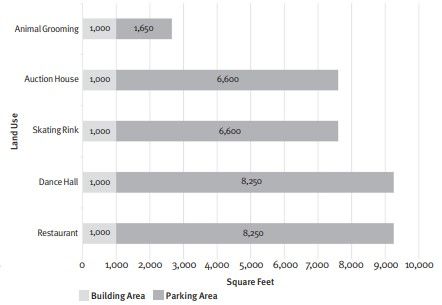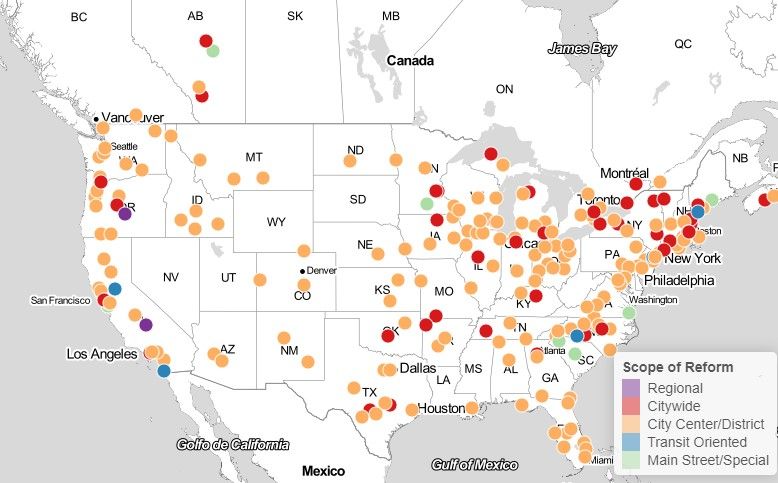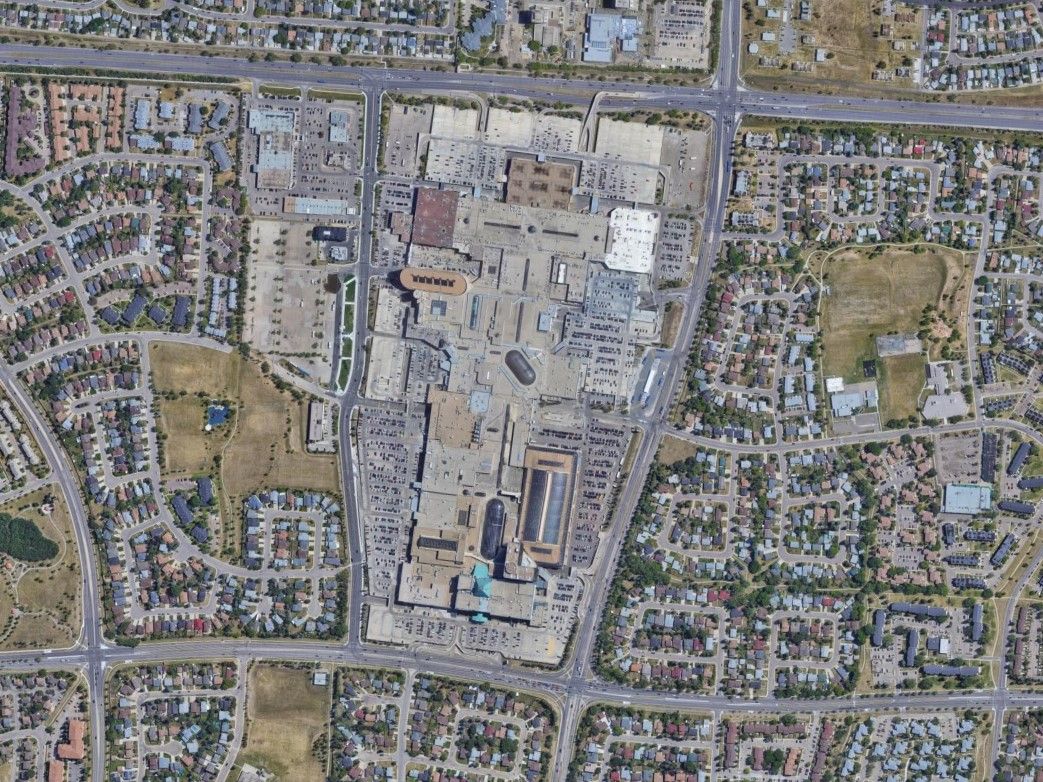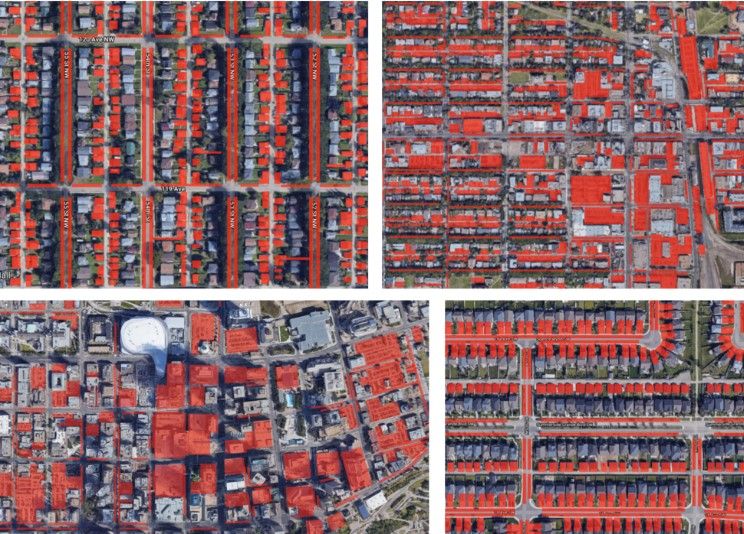How Parking Lots Shape Our Cities for the Worse
How Parking Lots Shape Our Cities for the Worse
For every boat at a marina in Miami, Florida, there is by law an equal number of parking spaces on land for cars. Strip clubs in Boise, Idaho, are required to have at least one parking spot outside for every three seats inside. In Fort Worth, Texas, sororities have one parking spot per two residents. A driving range in Baltimore, Maryland, will have 1.5 spots per tee stand, whereas a golf course in the same city will have three parking spots per hole.
Nearly every city in North America follows a rigid guide for mandatory parking minimums; that is, the number of off-street parking spots that a business, home, place of employment, or community space must build to comply with zoning bylaws.

Parking requirements are the invisible forces that shape much of our cities, almost always for the worse. They take up space and encourage environmentally destructive sprawl: a standard parking spot is about 17 sq meters, though this can more than double in size when you take into account the driveway surrounding the spot, which makes them comparable to small studio apartments. They’re terrible for local environments: their paved surfaces don’t absorb water, leading to pollutant-rich flooding during heavy rainfalls. They’re expensive to build: a parking stall can cost between $40,000-60,000, which is usually subsidized through higher rents and steeper prices at the businesses they service. Many people do not connect the short term benefits of ample parking (e.g., the convenience of driving one’s car as close as possible to the door of one’s destination) with its disastrous long term effects: the catastrophic impacts of climate change, a generation-defining housing crisis, and cities that are completely inaccessible to people without cars. And yet, for all their urban dominance, parking requirements are almost always completely arbitrary.
The Parking Bible
Professor Donald Shoup has been teaching urban planning at UCLA since 1974. He’s long been parking’s sharpest and most vocal critic, and his landmark 2005 tome, The High Cost of Free Parking, has become the definitive text for parking reform.
Clocking in at over 700 pages, The High Cost details the “pseudoscience” (Shoup’s words) behind parking minimums. Zoning ordinances in American cities started mandating parking in the 1930s, though it would take some time for it to become the standard—Los Angeles, for example, did not require off-street parking for commercial buildings until 1946. As the car rose in popularity, city streets faced increasing traffic. Motorists would circle the block, seeking limited curb space to park their cars, contributing to congestion. Thus mandatory parking minimums were born, a well-meaning initiative meant to ease traffic.
In order to set parking requirements, city planners go through a three step process. First, they define the specific use of land for a site. The Planning Advisory Service (PAS) lists 662 potential different land uses, including abattoirs, nunneries, landfills, tea rooms, and rifle ranges, though more common uses include schools, churches, and retirement homes. Next, planners must determine a unit of measurement related to the land use; often this is a measurement of floorspace, but it can also consist of the aforementioned boat slips, seats, and tee stands. Finally, they assign a number of parking spaces based on this unit of measurement. Some examples from the PAS include three spaces per 1,000 square feet (93 square meters) in a bicycle repair shop, one space per 10 nuns in a nunnery, 1.5 spaces per fuel nozzle at a gas station, and 1 space per 2,500 gallons (9,463.5 liters) of water in a swimming pool.
Determining the appropriate amount of parking at an establishment can be a tedious process, one that requires resources that many understaffed city planning divisions simply do not have access to. For decades planning students were taught little to nothing in the way of parking policy. Urban Land Use Planning by F. Stuart Chapin, which Shoup describes as the “bible of urban land-use planning,” makes no mention of parking. The issue is often dismissed by urban planners and transportation departments alike, each side assigning the issue to the jurisdiction of the other. Younger generations of planners and activists are becoming increasingly radicalized, thanks in no small part to Shoup himself and his acolytes of self-described “Shoupistas”.

PAS regularly publishes surveys on how different cities manage their parking. Though these are meant to be purely informative, they end up being treated as a guidebook; cities will copy other cities’ mandatory parking minimums, without giving any critical thought to how they were conceived. This is a casualty of parking policy being treated as an afterthought by planners who are not given the time, budget, or resources to calculate the amount of parking that actually makes sense for their cities. Sure enough, PAS’s own research has concluded that most of these standards are mysterious in origin. In their words, as cited in Shoup’s book, “Copying other cities’ parking requirements may simply repeat someone else’s mistakes.”
Other cities might refer to the Parking Generation Report published by the Institute of Transportation Engineers. This report is based on seemingly scientific studies, in which parking lots of various venues are observed for a set period of time, the number of cars parked in them is noted and plotted on a graph, and recommendations are extrapolated from this data. However, these extrapolations are extremely weak; a fast food restaurant’s parking lot might be observed over a period of five days, and become the standard for mandatory parking minimums for restaurants across the country. Most of the studies in the Parking Generation Report looked at suburban developments where the majority of trips are made by car, but its recommendations are then adopted by cities with walkable or transit rich neighborhoods. Finally, the parking minimums are often based on peak demand for a business. A mall has to have enough parking spaces to accommodate the number of shoppers on the Saturday before Christmas, regardless of how little the spots are used the rest of the year.
Changing Lanes

In 2010, software developer and labor organizer Tony Jordan became radicalized after reading The High Cost of Free Parking. Jordan was living in Portland but had grown up in Los Angeles, a city with an estimated 6 million parking spaces.
“I felt like I was eating a hamburger in the 1910s and just read [Upton Sinclair’s] The Jungle,” he tells me over video chat. “I was working in an office tower, overlooking a big parking structure. Now all of a sudden I could see the dollar signs. I could see the space it was taking up.”
Jordan was inspired to seek out other parking reformers, knowing that his background as an organizer could be helpful in getting people mobilized. He attended planning commission meetings, built mailing lists, networked with bicycle advocacy organizations, joined a Facebook group for Shoupistas, and created a spinoff group for Portland residents, which became Portlanders for Parking Reform. He still had a day job, and was paying out of pocket and using his vacation days to attend urbanist conferences and symposiums. In 2016, the group successfully lobbied Portland City Council to vote against new parking requirements in Northwest Portland. But Jordan had his sights set higher; he knew parking was a problem cities around the world were facing, and yet there was no centralized organization focused primarily on parking reform.
“They don’t teach you in school how to cause trouble,” he says. “But I know how to do this, and I want to help people in other cities do this.” In late 2018 he quit his job and in March 2020, along with planners Lindsay Bayley, Mike Kwan, and Jane Wilberding, he started the Parking Reform Network (PRN).
PRN is a young organization, which had the bad luck of launching at the start of a pandemic. Much of their current focus is on education, and they produce a podcast, a guidebook for activists, and a library of parking stories. They are at work growing their membership, which includes transportation planners, housing and environmental activists, civil engineers, students, and journalists (I am a member). Their most popular feature is an interactive map that shows all the cities that have repealed mandatory parking mandates. In 2017, Buffalo, NY became the first place in the United States to repeal these mandates city-wide. Now, the map of the United States is littered with dots.

A Case Study in Edmonton
Since Buffalo, NY made urbanist headlines for being the first North American city to remove parking minimums, other cities have been following suit, re-examining and updating the data that informs so much of their urban landscapes.
A more recent example can be found in the city of Edmonton, Alberta. Edmonton is a car city. Alberta is known as the oil capital of Canada, and their oil and gas resources provide the province with 22% of its revenue. Edmonton’s snowy season lasts from October until as late as May, a fact people like to bring up when arguing against expanding cycling infrastructure. It’s home to the gargantuan West Edmonton Mall, and with it, the world’s largest parking lot. People in Edmonton like to drive, which means they like to park.

Ashley Salvador didn’t want to get rid of parking entirely. She grew up on a farm an hour east of the city and knew that sometimes driving and parking were inevitable. Still, the sheer number of parking spaces in Edmonton struck her as excessive, and worse still, parking mandates were directly interfering with the housing crisis. In 2017, she was finishing a Master’s in Planning and her studies inspired her to launch YEGarden Suites, an advocacy organization providing guidance to those looking to build infill housing on their property.
Garden suites (small detached houses, usually found in the backyards of larger homes) are popular with college students, seniors, and people with disabilities, who want to live close to family while retaining a sense of independence. And yet, garden suites in Edmonton were beholden to the same parking minimums as other housing in the city, requiring a minimum of two parking stalls to be built alongside them. “I would hear stories from people who lived right next to a [light rail transit] stop who did not own cars, who were cycle commuters, and they were being forced to build parking with their suites. That’s what really got me interested in parking minimums.” Parking reform became a pet issue for them, and they were looking to broaden their impact.
“Amazing work was already happening internally at the City of Edmonton,” says Salvador. She and her YEGarden Suites colleague, Travis Fong, teamed up with Edmonton City planner Anne Stevenson to use the resources at their disposal to eliminate parking mandates in the city.

The trio focused on a multipronged approach that included both public outreach and data accumulation. They determined how much a parking space cost to build in Edmonton (from $7,000 for a single paved parking space to $60,000 per individual stall for an underground parkade). They created visual guides, taking satellite images of residential neighborhoods and highlighting in red the amount of spaces dedicated to parking (there was a lot of red). Meanwhile, a team of city staff led by Stevenson recommended a comprehensive review of the state of parking. A detailed technical study was conducted, similar to but much more thorough than the ITE studies discussed in The High Cost of Free Parking. 340 unique commercial and residential sites were surveyed across the city, based on different characteristics that would influence parking demand: transit access, density levels, and walkability scores. Sites were surveyed in winter and summer to observe the role that weather played. They also selected ten Tim Hortons sites, the ubiquitous Canadian donut and coffee chain, “to control as many variables as possible,” said Stevenson in a recorded lecture. They were able to supply quantitative data that Edmonton’s parking minimums, which were set in 1974, were excessive.
With this information, Edmontonians were polled to gauge support for parking reform. When given a choice between parking minimums, parking maximums (i.e., limits on the amount of parking that establishments could build), and Open Option parking (i.e., establishments could themselves determine how much parking was required based on market forces), Open Option was by far the most popular. While parking reform has long been popular amongst lefty environmentalists, framing the issue as one of government overreach in local business made Open Option an attractive alternative to those across the political aisle. “You can talk about how eliminating minimums is really fantastic from a climate resilience perspective and as well as a fiscal responsibility perspective,” Salvador tells me. The complete process was laid out in a recorded seminar.
In June 2020, based on the research and data that Salvador, Fong, and Stevenson presented, the City Council of Edmonton voted unanimously to drop its minimum parking requirements. The following year, in the fall of 2021, both Stevenson and Salvador were elected to city council, where they both continue to advocate for walkable communities, better public transit, and affordable housing. “Even over the ten months that I've been on council, we've had a number of projects come through our public hearing process that otherwise would not have been viable if parking minimums were in place,” she says.
Edmonton was not the first city to repeal parking minimums — one only has to look at the Parking Reform map to see how they fit into a larger trend — but this victory in a car-loving city with extreme weather is a promising marker that there is indeed a growing coalition that is rethinking how we build our cities around parking lots. Though parking policy is managed independently by different municipalities, activists are learning from people in different cities and improving methodologies for collecting data that haven’t otherwise been updated in decades. The movement is snowballing, with climate, housing, and urbanist groups showing up for the cause. California State Assembly member, Laura Friedman, specifically cited Los Angeles’ homelessness crisis when arguing for parking reform. Bloomberg’s CityLab called parking reform “the next step on climate action.” In late October 2022, three US cities repealed their minimums within the same week of each other, something that would have been incomprehensible even ten years ago.
“One of the reasons I [started Parking Reform Network] is, Donald Shoup is retired,” says Tony Jordan. “We need to build a thing that's more than one person. Everyone wants a speaker, and they're like, ‘can you help me get Shoup out?’ But he's 84 years old. He’s not flying out to talk to your city councilor.” But new generations have taken up the torch that Shoup lit with The High Cost of Free Parking. A mass movement is building, and it doesn’t require a car.




